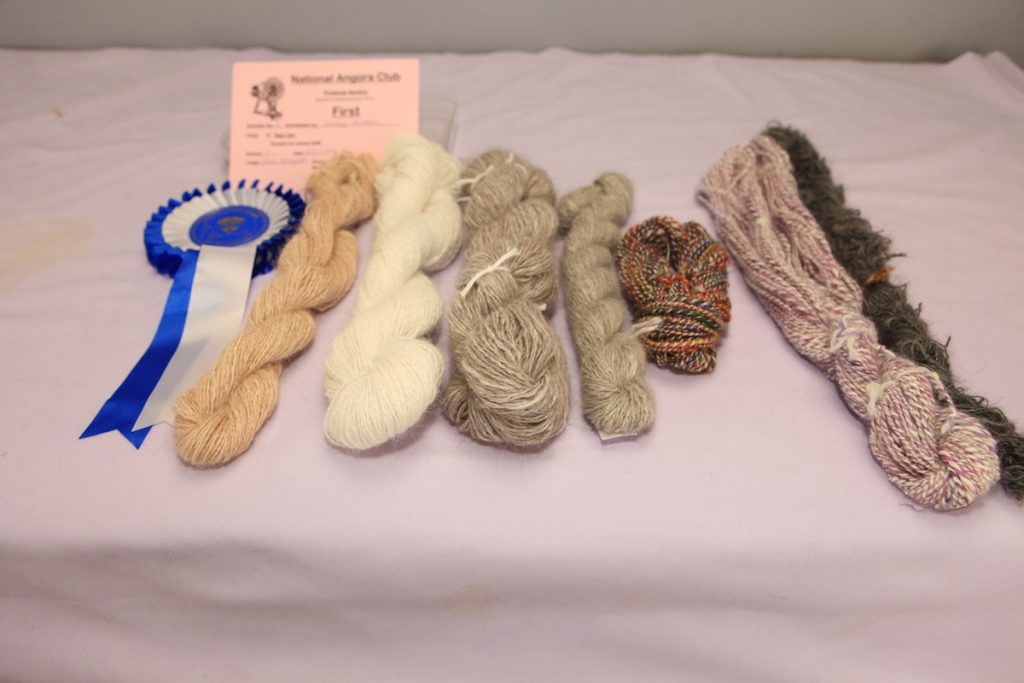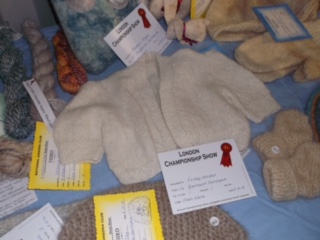The Products section – by Patsy Hirstwood
Clipped wool
Products begin with Clipped wool, and the main thing to watch here is that one does not ‘double clip’, this simply means that one must not have any short hairs amongst the long wool, for this immediately puts the entry at a disadvantage no matter the quality or colour of the wool.

When clipping make sure, between each narrow row of wool taken from the rabbit, that you do not clip the short ends left from the preceding row. Lay each row, as clipped into a container of a suitable size. A litre ice cream, or 2lb oblong margarine container is admirable, but first weigh the container when empty, and then weigh it again to ensure that you have the correct weight of wool.
Another point to watch when clipping, is that you do not have anything new coat protruding
into the base of the old one; for nothing looks worse than, say, an inch of coloured tips in the paler colour of the base. When your rabbits coats are at this stage they want plucking, not clipping.
Plucked wool
Plucked wool must be of the required length, it must also be free of cots and foreign matter (Hay etc) As you pluck each toosk, lay it in the container with all the root ends level: no judge will be hoodwinked by wool being laid in such a manner that it looks to be longer in staple than it actually is.
Both these classes always require1/4 oz of raw wool.

Spindle and wheel spun yarns
Spindle and wheel spun yarns all need to weigh ½ oz. First, weigh out the wool carefully. Next, try and not get too much twist in your yarns. To do this when spindle spinning do not revolve your spindle with such force that it fair birls round but twist it just enough to make the wool hold together nicely. Of, course, if one is twining two yarns to make a two-ply, then some of the twist will come out of the first threads, owing to it being spun the reverse way for the twining of it.
With wheel spun yarns ensure you at sat comfortably with a chair of the correct height to avoid strain. Try not to treadle your wheel too fast but go at an even gait. Whilst angora does require more twist than fleece, for instance, it does not require that amount more. Another point to bear in mind when using more than one thread in a yarn is that the fibres used are of a compatible nature; do not put a coarse hairy fibre with delicate angora fibres, the end result is not worth your time and efforts. If you want to be ‘ethnic’ use something other than angora for the purpose.

Article class
In the Article class, give a little thought before embarking, on the suitability of the yarn for the article. For instance, baby would maft in a thick, fluffy two-ply angora coat: Angora is one of the warmest fibres therefore a little goes a long way. If you wish to use 100% angora two-ply, then make it something light and airy, preferable a lacy pattern. If you use one thread angora wool alongside, bear in mind – a thread of a suitable commercial wool something like (Jaegar Fairiespun) then do not have little ‘urchins’ poking out all over the place; make sure the two yarns run through your fingers at the same rate while you knit or crochet them.
If you are twining a thread of angora with a thread of some other fibre then try and get them even twined, as angora us beautiful enough without any ‘fancy effects’ such as ‘boucle’. If you let the threads run through your fingers – one between index finger and the middle finger, then you will be alright. When joining in a new length of yarn during knitting/crochet Do not use knots: preferable join in at the end of a row so that the thread can later be used in the making up of the article. If it is something with no seams then darn these ends in neatly. I was ever taught the back side should be as neat and tidy as the front; it is a maxim I firmly believe everyone should adhere to.
If you should have to join your new yarn during a row of work, then leaving about 6” in of the old yarn and the same of the new and weave in the old wool as you knot or crochet the next inch or so: on the following row weave in the same length with the new wool.
You will end up with 2” overall woven section on the back; upon completion of the article this can then be cut off neatly. When making up an article with seams try and graft these whenever possible, otherwise make them as neat and tidy and ‘seamless’ as you possibly can. A little extra time here is worth the effort.

Definitions
- Toosk – A tuft of grass or hair, a mat or tangled mass, esp. of hair
- Maft – when it becomes unbearably hot and one feels sweaty and uncomfortable in the heat
NB: Images not part of original article but added for interest
